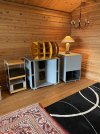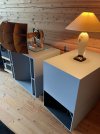I've found my tweeter!

The BlieSMa T34A-4
http://www.bliesma.de/product.html
http://hificompass.com/en/speakers/measurements/bliesma/bliesma-t34a-4
http://www.audioxpress.com/article/test-bench-the-t34a-4-tweeter-from-bliesma
http://www.troelsgravesen.dk/BlieSMa_T34A-4.htm
I was looking in a very different direction, using an ATC or Volt middome and crossing this over at 3 to 3.5kHz to the tweeter, perhaps Mundorf AMT21.
But then I was a bit hesitant about crossing over around 3 to 3.5kHz. I was thinking why am I hesitant about this.. Is it past speaker experience? I've had a bad experience around this region with the K+H O300 and to some degree several other speakers, it is the presence / harshness region. And speakers that cross lower haven't sounded harsh to me in this region. Also when looking at reviews of quality speakers which use a very low distortion ATC dome but again cross at ~3kHz they seem to give a magnifying glass to the mids but are particularly hard on songs and are not particularly good at giving a whole picture of the music. In contrast, for instance the Amphion speakers get rave reviews at how great they are at giving the whole picture and fantastic holographic soundstage and these cross over at 1.6kHz (with a waveguide and measurements still show a distortion bump around the crossover due to the tweeter being stressed). And these don't even measure as good as an ATC for instance. How can this be, while the crossover is smack in the middle of the midrange and there are so many testaments all over the internet on how not to cross over in the mids as this is where our ears are most sensitive.
And then it occured to me.. The equal loudness curve, doesn't this have a little dip in the middle?
I looked it up and it sure does!
View attachment 16010
And just look at that..
How can you get a more clear picture of where to cross over?

You cross over at ~1300-1400Hz!
And certainly not at 3-3.5kHz where the ear is ~6 to 9dB more sensitive.
And this is not just because of crossover slight off-axis phasing and ringing. There are many other things to consider around the crossover. Mid/woofer dropoff, change of diffraction due to different location of the drivers, shift in harmonic and non linear distortion signatures from the different drivers, even the effect on the ear/pinna of the different vertical placement of the drivers which is more sensitive in higher frequencies. All of these are ~6-9dB less audible when placing the crossover this low. And you get the most sensitive and important region of about 2-5kHz handled by a single driver. Coincidentally you also get easy near coaxial vertical phase behavior as discussed earlier in this thread

Perhaps an alternative could have been a mid driver handling 400Hz to 5-6kHz or so, but it feels less natural to me to cross over to a supertweeter at 5-6kHz or higher (hard to get a good in phase angle at the crossover due to the very small distance required to the mid driver) and I'm not sure if there is a mid driver that can do the ~400-6000Hz range well enough with room to spare around the crossover points.
Anyhow, this is how I found the BlieSMa driver. It's clear a 1" tweeter is not up to the task of this low a crossover even in a waveguide (compression driver in a horn is a different story but not suitable for my nearfield use) and the BlieSMa is the only one that can do it this well. Lucky I didn't want to design this speaker a year ago as there would have been no good tweeter yet for the task, the BlieSMa was only released this year

Btw, there is a beryllium version as well, the T34B-4, but I don't see any benefits other than for bats and a slightly enhanced sensitivity (and it does slightly worse in fact for the third harmonic around the crossover).
Now looking for a great woofer to go with the BlieSMa. Perhaps a Seas W18EX001 would be a natural match.. Could add a true sub later as well.


